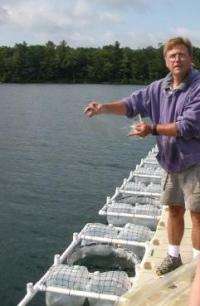How human activities affect the carbon cycle

(PhysOrg.com) -- Land uses influence nature?s absorption, release of CO2, says STEPS researcher.
About half of the carbon emitted by human activity rises into the atmosphere, where it helps contribute to global warming. The other half is absorbed by oceans, watersheds and plants, as part of what’s known as “the carbon sink.”
Some scientists are seeking ways to sequester carbon by pumping it into large cavities miles below the surface of the earth.
Donald Morris studies how lakes, rivers and other aquatic ecosystems absorb carbon dioxide (CO2).
Morris, associate professor of earth and environmental sciences, is an aquatic ecosystem ecologist who studies the role of dissolved organic carbon (DOC) in lakes, streams and rivers. He studies carbon dynamics in small watersheds, focusing on the role of land use and landscape in regulating the release or sequestration of DOC.
“Organic carbon is fixed into plant material and stored in the soil,” says Morris, who is affiliated with the university’s STEPS (Science, Technology, Environment, Policy and Society) initiative. “It enters the watershed and ends up in lakes and rivers. Eventually, it reenters the atmosphere, where it behaves as a greenhouse gas. That’s in part why we’re interested in what regulates the sequestration of that carbon.”
Morris says strong evidence suggests that human activity has accelerated the release of DOC into the atmosphere. He has worked with the Rodale Institute’s experimental farm to study carbon sequestration and find out how different crops and agricultural practices influence the export of organic carbon.
Microbial food webs affected by DOC and UV light
Morris is also studying a virgin watershed in the Alan Seeger Natural Area in central Pennsylvania. Undisturbed natural areas are rare in the northeastern United States, and Morris hopes to show how human activity has altered regional carbon dynamics since pre-Columbian times.
Much of Morris’s research is collaborative. He and his colleagues recently completed a large-scale study of the photobleaching of DOC at Lake Lacawac in northeastern Pennsylvania. They manipulated the amounts of DOC and ultraviolet light in several artificial enclosures, or mesocosms, to see how the two variables influence microbial food webs.
“Collaborative relationships are exciting because they offer new possibilities for research and new directions and perspectives,” Morris says. “All of us can benefit from interacting with people who look at the earth through a different lens.”
With Richard Weisman, professor of civil and environmental engineering, Morris developed the Lehigh in Costa Rica Program in 1997. Students travel to Costa Rica over winter break to study natural history and sustainable development in the region.
Stephen Cutcliffe, professor of science, technology and society, joined the team in 2007. In addition to the class on sustainable development, the program now includes a course on the natural history of Costa Rica.
“These courses allow me to take students on study abroad experiences,” says Morris. “That’s really exciting to me because I get to see Costa Rica and Latin America through their eyes. They get excited about international travel, Latin American culture, and natural history in Costa Rica. Our students frequently refer to the program as their defining Lehigh experience.”
Provided by Lehigh University
















